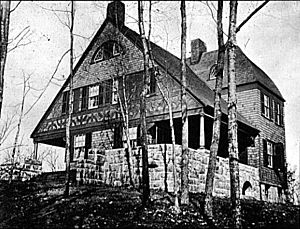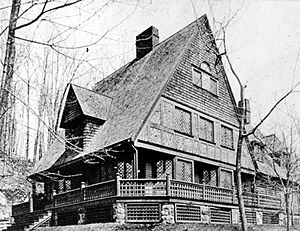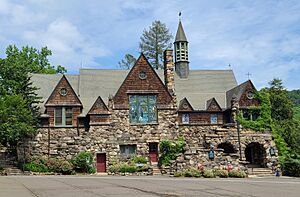Tuxedo Park, New York facts for kids
Quick facts for kids
Tuxedo Park, New York
|
|
|---|---|

Location in the state of New York and in Orange County
|
|
| Country | United States |
| State | New York |
| County | Orange |
| Town | Tuxedo |
| Area | |
| • Total | 3.22 sq mi (8.35 km2) |
| • Land | 2.66 sq mi (6.88 km2) |
| • Water | 0.57 sq mi (1.46 km2) |
| Elevation | 407 ft (124 m) |
| Population
(2020)
|
|
| • Total | 645 |
| • Density | 242.75/sq mi (93.73/km2) |
| Time zone | UTC−5 (Eastern (EST)) |
| • Summer (DST) | UTC−4 (EDT) |
| ZIP Code |
10987
|
| Area code(s) | 845 |
| FIPS code | 36-75803 |
| GNIS feature ID | 0968011 |
| Lua error in Module:Location_map at line 420: attempt to index field 'wikibase' (a nil value). | |
| Location | Tuxedo Park, New York |
| Built | 1886 |
| Architect | Bruce Price McKim, Mead & White Russell Sturgis |
| Architectural style | Tudor Revival, Italianate, Queen Anne |
| NRHP reference No. | 80002740 |
| Added to NRHP | March 13, 1980 |
Tuxedo Park is a small village in Orange County, New York. In 2020, about 645 people lived there. It is part of the larger New York metropolitan area. The village's name comes from a word in the Munsee language of the Lenape people. tucsedo or p'tuxseepu means 'crooked water' or 'crooked river'.
Tuxedo Park is a gated village. This means it has controlled entrances and is private. It is located in the southern part of the town of Tuxedo. It is close to New York Route 17 and the New York State Thruway.
The formal evening suit for men, known as a tuxedo, got its name from Tuxedo Park. A man named James Brown Potter brought this type of suit there. He learned about it from the Prince of Wales, who later became King Edward VII.
Contents
History of Tuxedo Park
The area around Tuxedo Park is in the Ramapo Mountains. A long time ago, people thought there was a lot of iron ore here. An English company bought a large piece of land to mine for iron. Later, in 1790, Pierre Lorillard II bought the company and its land. After the iron was gone, the land was used for cutting down trees.
How Tuxedo Park Started
The village began as a private hunting and fishing area in 1885. This was created by Pierre Lorillard IV. He built small houses and rented or sold them to his friends and family. The idea became very popular. So, he started the Tuxedo Club and the Tuxedo Park Association. He also built a tall fence around the property. This fence showed the boundaries of the private area for residents.


The first clubhouse in Tuxedo Park was built in 1886 by Bruce Price. A new clubhouse was built in 1928 by John Russell Pope. This building burned down in 1943 but was partly rebuilt.
The style of cottages built by Bruce Price in Tuxedo Park influenced later architects. These homes had a unique shingle style and influenced Modernist designers like Frank Lloyd Wright. The Queen Anne style with Tudor elements became popular for homes here.
Famous Residents and Growth
Tuxedo Park was very successful from 1885 until the 1920s. Emily Post, whose father was Bruce Price, wrote The Blue Book of Etiquette. She based her book on what she saw inside Tuxedo Park's gates.
Many notable people lived in Tuxedo Park during that time. Some of them include:
- Grenville Kane – a banker and heir
- Dorothy Draper – a famous interior designer
- Adele Colgate – an heir to the Colgate/Palmolive fortune
- George Fisher Baker – a banker
- J. P. Morgan – a very well-known banker
- Alfred Lee Loomis – an investment banker and scientist
- William Waldorf Astor
- Augustus Juilliard
- Millicent Rogers
In the 1920s, a new hospital and high school were built. This was thanks to generous donations from residents like John Insley Blair. After the Great Depression, Tuxedo Park lost some of its wealthy residents. However, new people moved in. One new home was built for Angier Biddle Duke. His father-in-law, George Baker St. George, was an original resident. He bought and built the "Duck Hollow" estate for Duke and his wife.
Tuxedo Park Today
Tuxedo Park officially became a separate village in 1952. Today, it covers about 2,050 acres (8.3 square kilometers). This includes three lakes and about 330 homes.
There are other housing areas outside the gated village but still in the Town of Tuxedo. These include the Tuxedo Heights Condominiums and The Woodlands at Tuxedo. The former home of Alfred Lee Loomis is now private rental apartments.
Outside the gated village, in the Town of Tuxedo, you can find other interesting places. These include the New York Renaissance Festival site. There is also a former International Paper Research Center, now owned by the Watchtower Organization. Just outside the gates of Tuxedo Park are historic buildings like the Tuxedo Train station, the Tuxedo Park Library, and the Tuxedo Park Post Office.
Tuxedo Park is important for its history and architecture. It was added to the National Register of Historic Places on March 13, 1980. This means it is recognized as a special historic district.
Geography and Nature
Tuxedo Park is located at coordinates 41°12′5″N 74°12′6″W.
The village covers about 3.2 square miles (8.3 square kilometers). Most of this is land, but about 0.6 square miles (1.46 square kilometers) is water.
Tuxedo Park is in Orange County, New York, near the border with Rockland County. It is nestled in the Ramapo Mountains.
Major roads like the New York State Thruway (Interstate 87) and New York State Route 17 pass east of the village. The village is north of Sloatsburg.
Sterling Forest State Park is to the west of the village. Harriman State Park is to the east. These parks offer many outdoor activities.
Inside the village, there are three lakes. Tuxedo Lake is the largest and provides drinking water for the village. The two smaller lakes, Weewah Lake and Pond #2, are used for fun activities. To keep the water clean, swimming and power-boating are not allowed in Tuxedo Lake.
Population and People
| Historical population | |||
|---|---|---|---|
| Census | Pop. | %± | |
| 1960 | 723 | — | |
| 1970 | 861 | 19.1% | |
| 1980 | 809 | −6.0% | |
| 1990 | 706 | −12.7% | |
| 2000 | 731 | 3.5% | |
| 2010 | 623 | −14.8% | |
| 2020 | 645 | 3.5% | |
| U.S. Decennial Census | |||
In 2020, the population of Tuxedo Park was 645 people. In 2000, there were 731 people living in the village. Most residents were white (94.4%). There were also smaller percentages of African American, Native American, and Asian residents. About 5.1% of the population was Hispanic or Latino.
In 2000, about 22.2% of the population was under 18 years old. The average age of residents was 45 years. The median income for a family in the village was $102,056.
Notable People from Tuxedo Park
Many interesting people have lived in or are connected to Tuxedo Park. Some of them include:
- Albert Einstein, a famous theoretical physicist
- Dorothy Draper, an American interior designer
- Sutton Foster, an actress, dancer, and singer
- Fred Gwynne, an actor
- Alfred Lee Loomis, an investment banker and scientist who helped invent the LORAN navigation system
- Howard Shore, a composer
- Katharine St. George, a former U.S. Congresswoman
- Katherine Rosman, a reporter for New York Times
- Henry Varnum Poor, who founded Standard & Poor’s
- Guy Spier, a hedge fund manager
Notable Locations in Tuxedo Park
- Jehovah's Witnesses World Headquarters
- I.B.M. Sterling Forest
Images for kids
-
Mark Twain at the Voss cottage, 1907.
See also
 In Spanish: Tuxedo Park (Nueva York) para niños
In Spanish: Tuxedo Park (Nueva York) para niños




